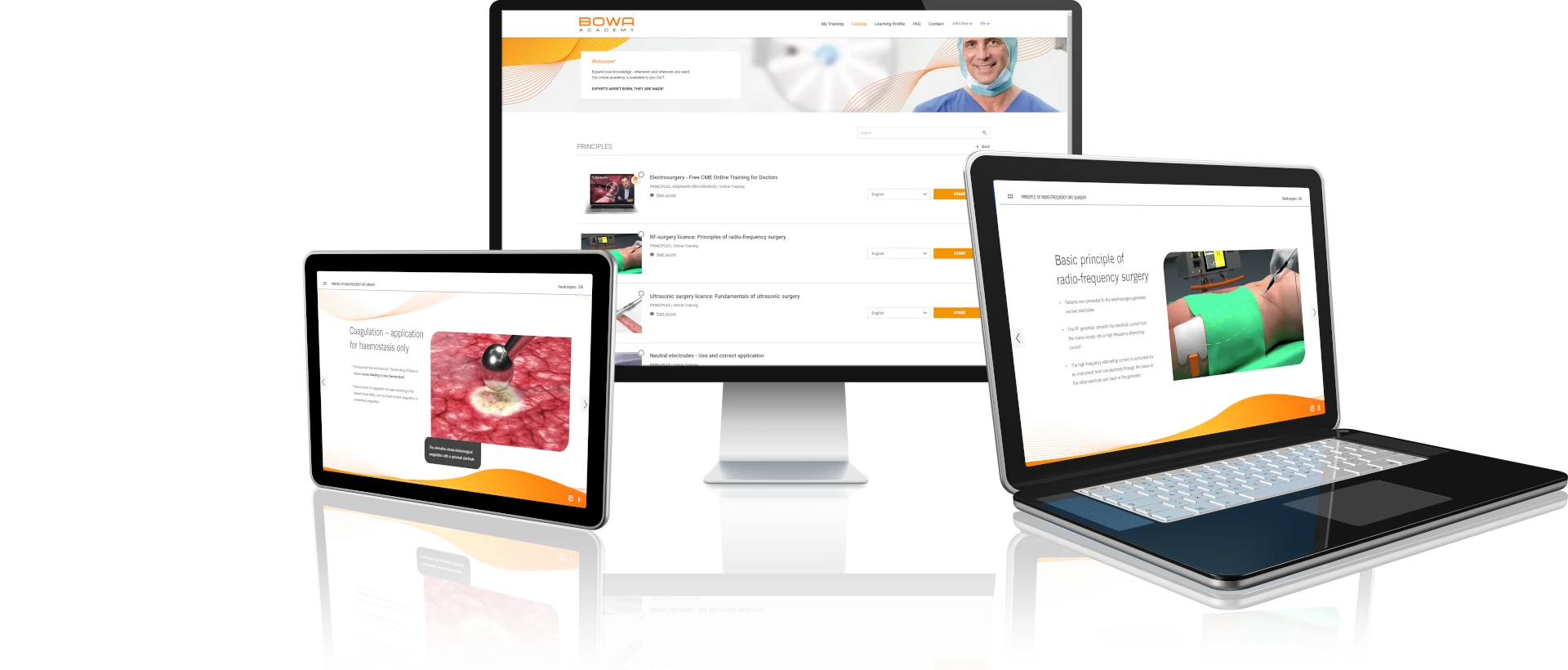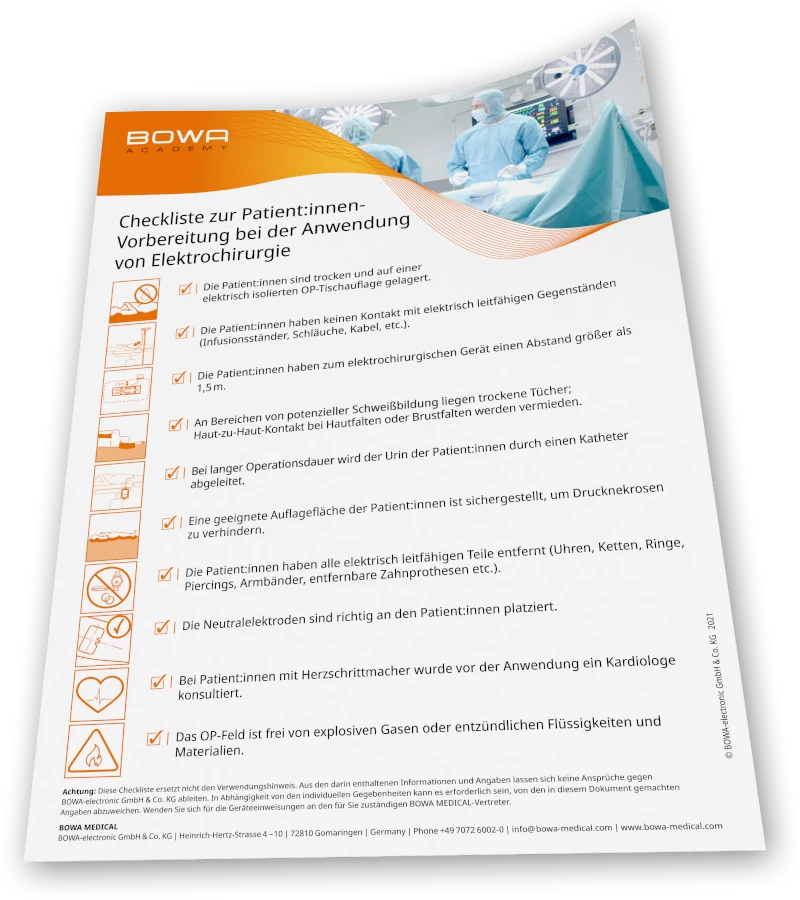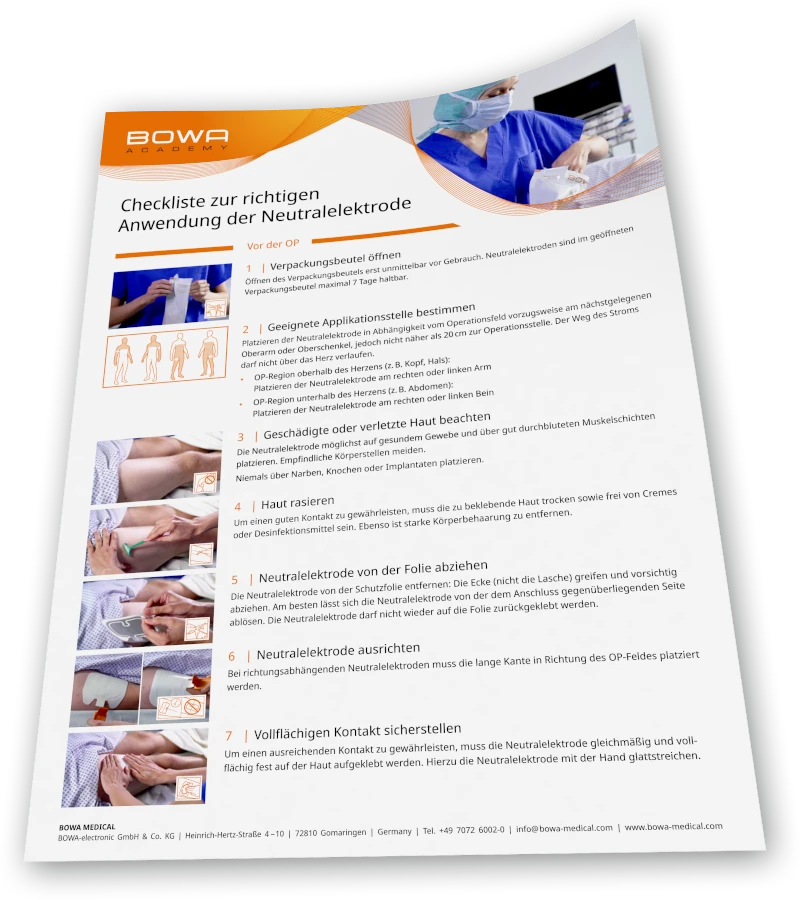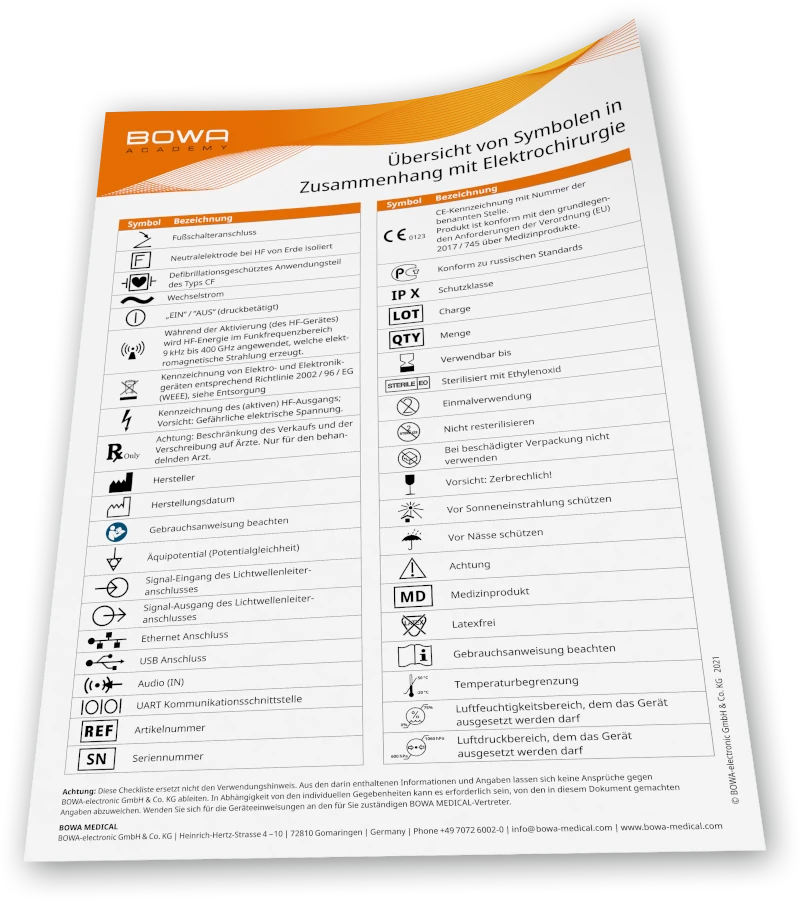BOWA Academy: Become an expert in ENERGY-BASED SURGERY
At the BOWA ACADEMY, you can experience practical training programmes from the specialist in energy-based surgery!
The training programme, specially developed for physicians and medical professionals, offers tailor-made content in the fields of HF- and ultrasonic surgery . The aim of the BOWA ACADEMY is to support users in the use of energybased surgical systems.
Discover the BOWA ACADEMY programme and become an expert!
Events in focus
Courses you should not miss!

Electrosurgery - Free online CME training for doctors
(in cooperation with DOCFLIX GmbH)
- Free participation incl. 2 CME points
- Practical CME course on HF surgery
- On demand: flexible at any time and any place
- Compact information in 45 - 60 minutes
E-Learning
Workshops
Cooperation partners
Learn effectively with our multimedia training programme
E-Learning
>7 languages
Responsive
Available 24/7
Online Training Courses
CME Certified
Hands-On
Available 24/7
Webinars / Livestreams
Interactive
On-Demand
Up-to-date topics
Classroom Training
Masterclass incl. CME
Hands-On training
Product Training
BOWA MEDICAL Events Calendar
Discover the latest BOWA MEDICAL events – from congresses and trade fairs to workshops and webinars. Take the opportunity to expand your knowledge and exchange ideas with us. We look forward to meeting you in person and setting new impulses together!
61. CONGRESSO BRASILEIRO DE CIRURGIA PLÁSTICA
XXIV Semana Brasileira do Aparelho Digestivo
Gynäkologie mit (neo)adjuvanten Systemkonzepten - Praktischer OP-Kurs
Livestream: In-Bag Morcellation and a new mindset in gynaecological surgery - with Prof. Dr. Günter K. Noé
Sicherer Umgang mit Hochfrequenzchirurgie in der OP- und Anästhesiepflege - Risiken erkennen und vermeiden
28. DÜSSELDORF INTERNATIONALES ENDOSCOPY SYMPOSIUM
143. Deutscher Chirurgie Kongress - Gemeinsam lernen und heilen
Become part of the BOWA ACADEMY
Register for free and benefit from exclusive courses and webinars on energy-based surgery.

Download: Checklists for HF surgery



symbols
What should be considered when using electrosurgery with regard to patient preparation?
We are happy to provide you with our brief overview in the form of a clear checklist.
- Ensuring a suitable operating field
- Correct positioning of the patient on the operating table
- Observe risks
What must be observed when using the neutral electrode?
We are happy to provide you with our brief overview in the form of a clear checklist.
- Determine suitable application site
- Correct placement and alignment
- Ensure complete skin contact
An overview of the most important symbols in electrosurgery
We are happy to provide you with our overview of symbols in connection with electrosurgery.
- The most important symbols
- Clear short explanations
FAQ: Interesting facts about HF surgery
In HF surgery, the desired thermal effect is produced by the flow of the current in the tissue itself (endogenous tissue heating). This has a range of different tissue effects in the patient’s tissue. In cautery, the tissue is heated from the outside (exogenously); it is only used for superficial haemostasis. Cutting tissue as in high-frequency technology is not possible with a cauter.
HF surgery enables stress-free cutting combined with simultaneous haemostasis of the tissue. It is an effective instrument for open surgical procedures as well as minimally invasive applications. Cutting and coagulation with high-frequency current is the gold standard in state-of-the-art surgery.
In HF surgery, an instrument passes a high-frequency alternating current through the tissue between two electrodes. By activating the HF instrument, the high-frequency alternating current generates heat in the tissue for the desired surgical tissue effects.
Electrosurgical cutting and electrosurgical coagulation.
Cutting: Vaporisation of intra- and extracellular fluid and destruction of cell membranes, resulting in a surgical incision.
Coagulation: Vaporisation of intra- and extracellular fluid without the destruction of cell structures. This leads to tissue shrinkage, seals the vessels and stops the bleeding, i.e. haemostasis. Coagulation normally uses voltages below 200 V while higher voltages are used for cutting.
In electrosurgery, alternating currents with a frequency of over 200,000 Hz (200 kHz) are used. This frequency range does not result in neuromuscular irritation.
The yellow switch on the handle and the foot pedal activates the cutting current, whereas the blue switch activates the coagulating current. This colour code is an international standard.
In monopolar HF surgery, current flows from the active electrode through the tissue to the neutral electrode. In bipolar HF surgery, two active (and usually equal) electrodes are integrated into the instrument. Current only flows in the specific tissue region grasped between the two electrodes. A neutral electrode is therefore not required.
Key factors to achieve the desired tissue effects include:
- Tissue impedance
- Electrode geometry (current density)
- Amount of energy introduced
- Application duration
- Type of current applied
- Homogeneous surface coagulation with limited penetration depth
- Contactless procedure results in no tissue sticking to the electrode
- Low smoke production, i.e. better view of the operating field
Bipolar vessel sealing can be used to seal vessels up to 7 mm. The sealing cycle is controlled by the generator and sealing mode. An autostop signal automatically ends the process. Using this vessel sealing technology reduces the need for clips and ligatures.
Neutral electrodes are designed to close the current circuit between the patient and the HF generator. Neutral electrodes are only required in monopolar technique.
Neutral electrodes are attached to the patient’s skin over a large area and without wrinkles. Where possible, depending on the location of the surgical site, place the neutral electrode on the nearest upper thigh or upper arm. Always make sure to keep a minimum distance of 20 cm between electrode and surgical site. The path of the current must not pass through the heart!
To minimise current density and, thus, local heating. This prevents any risk of thermal lesions on the surface of the skin.
Our cooperation partners
The BOWA ACADEMY works closely with numerous international research and educational institutions.